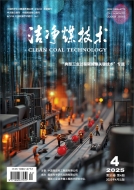Against the backdrop of global carbon emission reduction,ammonia is receiving increasing attention as a cheap,safe,easy-to-store and transport zero-carbon fuel. Utilizing ammonia to replace coal combustion for power generation is an important way to reducecarbon emissions. The combustion characteristics of ammonia with low calorific value,slow combustion rate and high NOx emission arethe difficulties that need to be faced when blending ammonia in coal-fired boilers. In this paper,the experiment of coal-ammonia co-firingunder the condition of deep air classification was carried out in a two-stage drop tube furnace reaction system. The effects of temperature,separated secondary air ratio and ammonia blending method on the combustion characteristics of coal-ammonia co-firing were studied.The experimental results show that when ammonia is added to the primary air,NO emissions increase monotonically with temperature,and sharply increase after 1200 ℃. NO first decreases and then increases with the increase of the separated secondary air,and the optimalseparated secondary air ratio is around 30%. When ammonia is added to the separated secondary air,due to the SNCR effect of NH3,NOemissions are lower below 1100 ℃,which is comparable to pure coal combustion under low co-firing conditions. As the separatedsecondary air ratio increases,NO emissions first decrease and then increase,and the optimal separated secondary air ratio is 20%. xExperimental results have shown that appropriate air distribution can control the NO emissions of coal ammonia co combustion with a cocombustion ratio below 20% without increasing the ratio of pure coal combustion,and the CO emissions and fly ash carbon content arelower than those of pure coal combustion. Therefore,NH3 can be used as an alternative fuel to reduce CO2 emissions from coal-firedpower plants.
Experimental study on NOx formation characteristics of coal and ammoniaco-firing in deep air staging mode
 2025 No. 04
2025 No. 04
 95
95 29
29

Authors:
- CUI Liming
- LI Xiongwei
- ZHANG Yixiang
- ZHANG Su
- CHU Wei
- LI Ming
- TAN Houzhang
- WANG Xuebin

Unit:
- China Shenhua Energy Company Limited
- CHN Energy Investment Group Co.,Ltd.
- MOE KeyLaboratory of Thermo-Fluid Science and Engineering (Xi’an Jiaotong University)
- Yantai Longyuan Power Technology Co.,Ltd.

Abstract:

Keywords:
- ammonia
- co-firing
- air classification
- blending method
- NOx

Citation format:
崔立明(1973—),女,河北石家庄人,高级工程师。E-mail:cuilm@shenhua.cc

Chart:
--

Articles:
--

Citation format:
CUI Liming,LI Xiongwei,ZHANG Yixiang,et al. Experimental study on NOx formation characteristics of coal andammonia co-firing in deep air staging mode[J].Clean Coal Technology,2025,31(4):78−84.

-
Executive director
China Coal Science and Industry Group Co., Ltd
-
Sponsored by
Coal Science Research Institute Co., Ltd
Coal Industry Clean Coal Engineering
Technology Research Center -
Editor in Chief
XIE Qiang
-
Vice Editor-in-Chief
YU Chang
SHI Yixiang
ZHAO Yongchun
DUAN Linbo
CAO Jingpei
ZENG Jie -
Publication Frequencies
Monthly
-
ISSN
1006-6772
-
CN
11-3676/TD
Covered by
- CSTPCD
- RCCSE(A+)
- AJ
- EBSCO host
- Ulrichsweb
- JST
- Scopus
Contact us
New Media
-
 Meichuanmei
Meichuanmei -
 Clean Coal Technology
Clean Coal Technology -
 Online Journals
Online Journals


 Submission system
Submission system Copyright agreement
Copyright agreement Instructions for authors
Instructions for authors